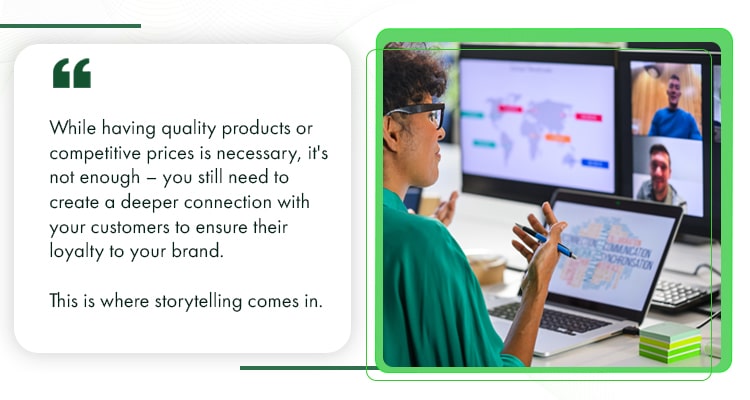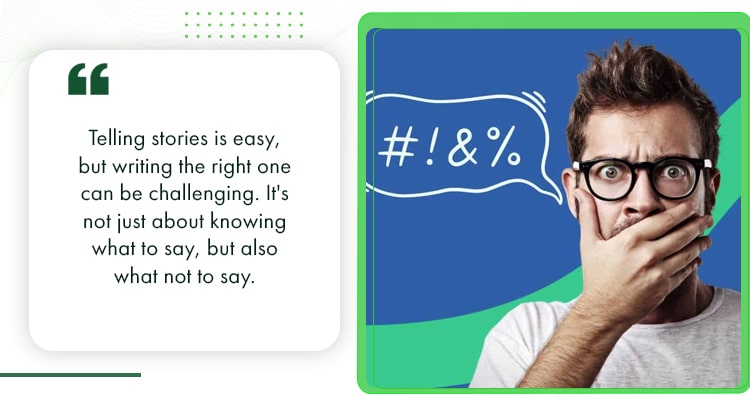Never underestimate the power of a story.
A powerful story can change opinions, influence actions, and provide inspiration. If you’re running a business, it can also shape how your target audience engages with your products and services. Thus, every brand should have and own their story.
But how is this done? How can you craft a compelling narrative that helps you stand out from your competitors?
In this article, we’ll explore the power of storytelling in business and show you how to craft your own story in a simple yet impactful way.
Read on to know more.
Why Storytelling Matters for SMBs
Every small and medium-sized business (SMB) knows how difficult it is to stand out
While having quality products or competitive prices is necessary, it’s not enough – you still need to create a deeper connection with your customers to ensure their loyalty to your brand.
This is where storytelling comes in.
 A well-crafted story goes beyond just a logo, product, or service. It reveals the people behind the business. Since people are naturally drawn to stories, they tend to appreciate brands that are transparent and genuine.
A well-crafted story goes beyond just a logo, product, or service. It reveals the people behind the business. Since people are naturally drawn to stories, they tend to appreciate brands that are transparent and genuine.
Storytelling creates a shared experience, making customers feel connected to your brand’s story and, eventually, turning them into passionate advocates.
So, how can you create a great story for your brand?
How Storytelling can 10x Your Brand
Stories create connections and if you do it right, it creates long-lasting impressions. Take a look at Donald Miller, author, public speaker, and business owner known for his marketing company, StoryBrand.
Donald Miller’s Storytelling Principles
Miller supports the notion that the customer is the hero of the story, and your brand’s role is to guide them.
He also believes every hero has a problem, and it’s your brand’s goal to help them overcome it by offering a clear, simple plan.
Next, create a clear call to action (CTA) that leads customers toward their goal. Highlight the consequences of failure and the rewards of success to motivate your audience to act.
More importantly, Miller emphasises that clear messaging is crucial, as confused customers don’t make purchases.
Miller’s Way of Storytelling
If you’re running an accounting firm, don’t just say you can do bookkeeping and accounting services.
Instead, here’s how you can incorporate Miller’s StoryBrand framework in your marketing campaigns:
“You’re a talented graphic designer, but taxes and bookkeeping aren’t your thing. That’s where [your company] comes in.
We get the financial challenges creatives face and will handle the stress so you can focus on what you love – designing!
Book your FREE consultation today, and let us help you achieve financial freedom.”
This approach helps attract creatives who feel overwhelmed by taxes, expenses, and bills. It also positions you as an empathetic guide, ready and willing to help them overcome their challenges.
When done right, telling stories with your customers as heroes will have 10x more impact than simply listing your product or service features.
Social Media Influencers/Storytellers
Storytelling has become even more powerful with social media.
Brandon Stanton, creator of “Humans of New York,” shares photos and short interviews of everyday people. It started in New York City but now includes stories from around the world. His powerful storytelling led to best-selling books, a huge following, and income from book sales and sponsored content.
Jimmy Donaldson, also known as MrBeast, is another great storyteller. His YouTube videos feature challenges and giveaways, but he also shares powerful stories, like building 100 water wells in Africa to give clean water to 500,000 people.
His personal journey, his team’s energy, and the emotional pull of his giveaways keep viewers hooked. As of writing, he has 388 million subscribers on YouTube and 67.7 million followers on Instagram.
Understanding the Elements of a Powerful Brand Story
A powerful brand narrative should not be a chronological account of your business’ history.
Thus, don’t make the mistake of listing dates, names, and numbers just to explain how you started. Instead, focus on understanding the key elements of a powerful brand story and use them to tell yours:
1. The Hero (Your Customer) vs. The Guide (Your Brand)
Make your customer the main character of your brand story. Imagine them as someone facing a challenge, seeking a solution, and striving for a better outcome.
Next, position your brand as the guide. Offer the tools, knowledge, and support to help your customer (the hero) overcome their challenges. Your goal is to empower them, making them feel in control of their journey, with you as their guide.

As a guide, show your expertise and empathy. Demonstrate that you understand their struggles and are committed to their success. Most importantly, remember: You are not the hero – the customer is.
The guide exists to serve the hero. Your brand is there to help your customers.
2. Crafting a Relatable Problem and Presenting Your Business as the Solution
Once you identify the characters, define the problem. Focus on the hero’s pain points, making them relatable and specific, so your target audience can see themselves in the story.
For example, if you offer car rental services, highlight the challenges of traveling without comfortable transportation in a new place. Show how crowded buses or trains can be, and how inconvenient it is to navigate a city without access to a car.
Then, show how your service can help them. Focus on the benefits your business provides, rather than just the features.
Instead of focusing on the car’s mileage, specs, or turbo engine, show how it lets them travel to different places quickly, without the stress of rushing to catch the next train. Help them imagine exploring a new city at their own pace, visiting tourist attractions without worrying about train schedules.
When you approach it this way, choosing your business feels like the natural outcome of the story.
3. Using Emotion to Create a Deep Brand Connection
People may forget a product name, but they’ll remember a story.
Emotions like joy, hope, empathy, or even anger are powerful motivators. That’s why many brands use storytelling to make customers laugh, cry, or feel angry. When done right, these stories create memorable experiences, leaving a lasting impression of the brand.
So, if you’re running a brand campaign, be intentional with your narrative. Share stories that are relatable and memorable for your audience. Use vivid language, imagery, and sound to create a sensory experience and emotional connection.
While facts like names, dates, or events are easily forgotten, customers will remember how an ad, poster, or online post made them feel.
For it to work, you need to do it right. Share genuine stories, like your brand’s humble beginnings, behind-the-scenes struggles, or employees’ success stories. The key is authenticity. Be real and honest—otherwise, a simple internet search could disprove your narrative.
Defining Your Brand’s Core Narrative
Your small business marketing should align with your brand’s core narrative. What do you want to achieve? What’s the driving force behind your stories?
In other words, your brand’s core narrative is the foundation for all other stories. It defines who you are, what your brand stands for, and why it exists.
Identifying Your Mission, Vision, and Values
Every business needs to understand its purpose. That’s why it’s important to craft your mission statement—your why. It defines your purpose and guides what you do every day.
It should be concise, clear, and actionable.
 For example, Canva, an Australian online design and visual communication platform, states its mission “to empower everyone in the world to design anything and publish anywhere.”
For example, Canva, an Australian online design and visual communication platform, states its mission “to empower everyone in the world to design anything and publish anywhere.”
Based on this premise, the company grew into a 49 billion AUD business with over 220 million monthly active users creating more than 30 billion designs across 190 countries.
How to Make Your Brand Story Authentic and Memorable
Customers are no longer passive when it comes to brand stories; they can easily spot fake or made-up narratives.
Fortunately, there are ways to make sure your brand story feels authentic, genuine, and unforgettable. Here’s how:
- Be True to Your Roots. Share your genuine beginnings – focus on the challenges you’ve overcome and the motivations behind your success.
People connect with realness. Show the people behind your brand – share stories of your employees, customers, and community.
- Craft a Clear Story. Stories trigger emotions like joy, hope, empathy, or nostalgia. Use these powerful feelings to shape your narrative.
Also, structure your story with a clear beginning, middle, and end, and bring it to life with vivid language, imagery, and sensory details.
- Know Your Audience. Understand your target audience’s values, needs, and aspirations.
Ask customers for their feedback on your brand and use this insight to shape your narrative. Then, customise your stories to connect with them on a deeper level.
- Focus on Your “Why”. Clearly define your mission and purpose.
What is your business aiming to achieve? Why does your business exist beyond just making a profit? What impact do you want to have?
Choosing the Right Platforms for Your Brand Story
Once you have a compelling narrative, it’s time to choose the right platform. Here are a few options:
1. Websites and Blogs
Every company needs a website for authenticity and credibility. It serves as your brand’s home base, offering a central hub for your story. Through your website, you can provide detailed information and have full control over your brand’s narrative and messaging.
Meanwhile, blog posts are essential for in-depth storytelling. You can write engaging stories paired with relevant images to attract more attention. When done right, long-form blog posts help establish credibility and build trust.
For instance, you can also share customer success stories, behind-the-scenes glimpses, and thought leadership articles to further engage your audience and build a stronger connection.
2. Social Media
If you prefer short-form content, social media platforms are the way to go. Facebook, Instagram, and X (formerly Twitter), are perfect for bite-sized stories, enabling quick communication and relationship building.
For example, you can share snippets of your brand story through images, videos, and posts. You can also offer your audience a glimpse into your daily operations or company culture.
 With the help of a social media virtual assistant or a virtual social media planner, some companies even let their audiences share their own stories and experiences with the brand through polls, quizzes, and contests. In fact, you can also host live Q&A sessions, product demonstrations, and behind-the-scenes tours.
With the help of a social media virtual assistant or a virtual social media planner, some companies even let their audiences share their own stories and experiences with the brand through polls, quizzes, and contests. In fact, you can also host live Q&A sessions, product demonstrations, and behind-the-scenes tours.
This strategy is effective because social networking sites reach a wide audience in a short amount of time. It also provides real-time updates when someone leaves a comment, interacts with your post, or shares your updates.
3. Video Storytelling
Customers now prefer short-form content, with 15- and 30-second videos dominating social media and becoming the top choice for advertising.
Video storytelling is powerful because it taps into emotions more effectively than text or images. They are also highly shareable, with online users more likely to share them than other content types.
Additionally, people tend to retain information better when it’s presented in video format, especially when simplifying concepts or showcasing product features, compared to just using text or images.
More importantly, videos highlight the human side of your brand by sharing its origin, mission, and values. By featuring your staff, customers, or target audience, you create a relatable and memorable connection with viewers.
The Role of a Social Media Virtual Assistant in Storytelling
Creating brand stories is a journey that involves research, brainstorming, and experimentation. The good news is, you don’t have to do it alone.
How a Social Media Virtual Assistant Helps Craft Brand Narratives
Writing stories often requires the expertise of a remote content creator or writer.
However, you also need a social media virtual assistant (VA) to develop a content calendar that aligns with the brand’s narrative.
They can also help with:
- Creating engaging micro-stories, captions, and visuals;
- Adapting the brand’s story for different platforms;
- Tracking metrics like engagement, reach, and followers;
- Offering insights to optimise content;
- Managing multiple accounts;
- Staying updated on trends and algorithm changes; and
- Scheduling posts.
Tools and Techniques Used by Remote Content Creators
To accomplish all of these tasks, a social media VA and a remote content creator use various tools to improve business storytelling techniques.
For instance, here are some common apps and software used for content creation and design:
- Graphic Design Tools
-
- Canva
- Adobe Creative Suite (Photoshop, Illustrator, InDesign)
- Figma
- Video Editing Apps and Software
-
- CapCut
- InShot
- Adobe Premiere Pro
- DaVinci Resolve
- OBS Studio
- Loom
- Image and Video Resources
-
- Unsplash
- Pexels
- Pixabay
- Adobe Stock
- Shutterstock
- Audio Editing
-
- Adobe Edition
- Audacity
Meanwhile, social media management and monitoring are easier with the help of:
- Social Media Scheduling Tools
-
- Hootsuite
- Buffer
- Later
- Social Listening Tools
-
- Sprout Social
- Mention
- Analytics and Reporting
-
- Google Analytics
- Facebook Insights
- Twitter/X Analytics
- Instagram Analytics
Building an Online Community Around Your Brand Story
Creating engaging stories is not enough; you also need to share them with the right audience. This is where an online community manager comes in.
The Role of an Online Community Manager
An online community manager is the main storyteller in your brand’s online community. They handle community building, content curation, engagement and moderation, and community advocacy.
Here’s what they do:
- Attract and identify your target audience;
- Share engaging, relevant content;
- Encourage user-generated content (UGC);
- Respond to comments, messages, and questions;
- Resolve conflicts and issues;
- Identify brand advocates;
- Gather community feedback and insights;
- Track metrics like engagement and growth;
- Monitor community trends; and
- Organise online or offline events to connect the community.
Creating Interactive Experiences Through Storytelling
Interactive storytelling turns passive listeners into active participants. For example, you can create polls to gather insights or offer content that encourages participation.

Some brands feature UGC on their websites or social media, encouraging customers to share their stories and experiences with the brand.
Live Q&A sessions and webinars, on the other hand, allow your audience to interact with your team and ask questions. These sessions offer a chance to share behind-the-scenes insights and expert knowledge, highlighting your products or services and how they’re made.
The Power of Data-Driven Storytelling
To be effective, a brand narrative must be supported by data. Brands should focus on data-driven storytelling, creating stories that resonate with the target audience based on real experiences and preferences.
Here’s how:
Using Analytics to Measure Storytelling Success
You can check the effectiveness of your storytelling by looking at social media engagement metrics such as likes, shares, comments, saves, reach, impressions, and follower growth.
You can also track your website’s page views, bounce rate, time on page, scroll depth, and click-through rates. For videos, check metrics like views, watch time, completion rate, shares, and comments.
Some brands even use sentiment analysis or social listening to monitor online conversations about their products or services. This helps identify the overall sentiment toward the brand and its stories.
A/B Testing Different Storytelling Formats
Also known as split testing or bucket testing, A/B testing compares two versions of content to see which one resonates more with viewers.
Here are different ways to do it:
- Headline Testing – Try different blog titles to see which one gets the most clicks and engagement.
- Video vs. Text – Test whether your audience prefers video or text-based stories.
- Visual Testing – Compare different images, videos, or graphics to see which one appeals most to your audience.
- Story Length Testing – Try long-form and short-form stories to see which ones keep the audience engaged.
- Call-to-Action (CTA) Testing – Test different CTAs to see which ones lead to the most conversions.
- Platform Testing – Check which platforms work best for different types of stories.
Common Storytelling Mistakes to Avoid
Telling stories is easy, but writing the right one can be challenging. It’s not just about knowing what to say, but also what not to say.

Thus, here are some storytelling mistakes you should avoid:
1. Overcomplicating Your Brand Message
It can be tempting to include everything, like too much information or technical terms, to cover all the details. However, this can cause you to lose focus on the core message.
A good storyteller, however, conveys simple yet powerful messages.
Instead of using jargon or complex language, use simple words that everyone can understand. Focus on the most important part of your story and deliver one clear, concise message.
Lastly, keep it short. The shorter (and simpler) the story, the easier it is to remember.
2. Being Too Sales-Driven Instead of Story-Driven
Small businesses can also fall into the trap of focusing on product features rather than building an emotional connection.
While this approach is understandable, it can backfire, leading to a brand narrative that feels inauthentic and lacks a genuine human connection.
Instead, focus on the hero. Remember, your customers are the heroes of your story, not your brand. As such, offer valuable content that educates, entertains, or inspires your audience.
FAQs on Brand Storytelling for SMBs
Here are some frequently asked questions (FAQs) about brand storytelling.
1. What Makes a Brand Story Compelling?
A good brand narrative feels authentic and human. It acknowledges challenges and vulnerabilities, making the audience feel understood and connected to the brand.
It also taps into emotions like joy, hope, empathy, and nostalgia. Additionally, it features relatable characters and speaks directly to the audience’s desires, pain points, and aspirations.
As a result, it creates a sense of belonging, making customers feel like they’re part of a community.
2. How Often Should I Update My Brand Story?
There’s no one-size-fits-all approach to how often you should share your brand story. The key is to keep it relevant to your brand’s evolution.

You should also consider the following factors:
- Significant business growth or expansion into new markets;
- Changes in your target audience’s demographics;
- Evolving social trends and cultural shifts;
- Refinement of your brand’s mission, vision, or values; or
- Emerging technologies.
However, even when there are no significant changes, it’s a good idea to schedule regular reviews, either annually or bi-annually, to ensure your story remains relevant and relatable.
3. What Are the Best Free Tools for Storytelling on Social Media?
The following tools can help you create compelling stories for social media:
- Canva – Canva offers an easy-to-use interface with a large library of templates, images, and fonts ideal for social media posts, memorable logo and visuals.
- Unsplash – This platform offers high-quality, royalty-free stock photos for your posters and other graphic needs.
- CapCut – CapCut is a powerful mobile video editing app that lets you edit videos, add effects, text, and music for free.
Conclusion: The Future of SMB Storytelling
In today’s competitive market, storytelling isn’t just a marketing strategy for SMBs; it’s also a way to connect with your audience and grow your following.

So, how do you develop powerful narratives for your brand?
- Start with a captivating hook to draw attention.
- Focus on authentic storytelling – with your customers at the center.
- Create narratives that are relevant and relatable.
- Make your customers laugh, feel hope, and empathise with your brand’s story.
If you do all of this right, the sales will follow.
For more information on how to tell the right stories with the help of a social media virtual assistant, call us today or request a callback now.
Syrine is studying law while working as a content writer. When she’s not writing or studying, she engages in tutoring, events planning, and social media browsing. In 2021, she published her book, Stellar Thoughts.




















